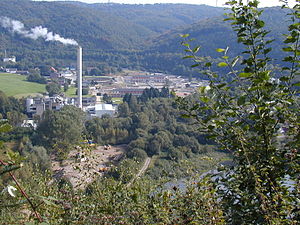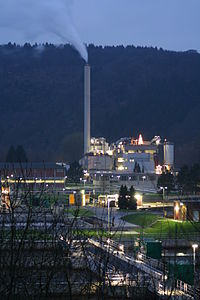Buchenhofen sewage treatment plant
| Buchenhofen sewage treatment plant | |||||||
|---|---|---|---|---|---|---|---|
| Buchenhofen sewage treatment plant | |||||||
|
|||||||
|
|
|||||||
| Coordinates | 51 ° 13 '28 " N , 7 ° 6' 24" E | ||||||
| Data on the structure | |||||||
| Extension size: | 600,000 PE | ||||||
| Affiliated population value: | 339,236 PE | ||||||
| Construction time: | 1906 | ||||||
| Amounts of water | |||||||
| Wastewater amount: | 39,533,794 m³ / a | ||||||
| Wastewater volume: | 48,578,889 m³ / a | ||||||
| Average drainage values | |||||||
| BOD 5 : | 2.14 mg / l | ||||||
| COD : | 20.00 mg / l | ||||||
| P tot : | 0.17 mg / l | ||||||
| NH 4 -N : | 0.18 mg / l | ||||||
| N anorg. : | 5.63 mg / l | ||||||
| Residues | |||||||
| Screenings: | 813.05 mg / a | ||||||
| Sand traps: | 292.07 mg / a | ||||||
| Sludge dry matter: | 6884 mg / a | ||||||
| Power generation | |||||||
| Sewage gas generation: | 4,714,384 m³ / a | ||||||
| Sewage gas utilization: | 99.90% | ||||||
| Power generation: | 7,789,548 kWh / a | ||||||
| Technical facilities | |||||||
| Sand trap: | 3 chambers with 1500 m³ | ||||||
| Coarse screen: | 2 pieces (40 mm rod spacing) | ||||||
| Fine rake: | 3 pieces (5 mm rod spacing) | ||||||
| Screenings washing presses: | 2 pc. | ||||||
| Screening presses: | 1 pc | ||||||
| Step rake: | 2 pieces (gap width 6 mm) | ||||||
| Sand classifier: | 2 pc. | ||||||
| Primary clarifier: | 2 pieces with 9450 m³ | ||||||
| Turbid water storage: | 1 pc with 1950 m³ | ||||||
| Denitrification basin: | 12 St. (+ Bio-P) with 49,000 m³ | ||||||
| Aeration basin: | 6 pieces with 54,000 m³ | ||||||
| Secondary clarifier: | 10 pieces with 63,000 m³ | ||||||
| Flocculation Filtration: | 1 pc with 1680 m² surface | ||||||
| Pre-thickener and mixing tank: | 2 pieces with 2200 m³ | ||||||
| Thickening centrifuges for excess sludge: | 4 pieces with 320 m³ / h throughput | ||||||
| Digester: | 3 pieces with 18,300 m³ | ||||||
| Gas storage: | Low pressure tank with 200 m³, high pressure tank (4 bar) with 1000 m³ |
||||||
| Chamber filter presses: | 2 pc. | ||||||
| Others | |||||||
| Particularities: |
Affiliated hydropower plant with 560 kW electr. Power, |
||||||
| Sludge incineration plant | |||||||
The Buchenhofen sewage treatment plant is the central sewage treatment plant in the Bergisch city of Wuppertal and one of the most important wastewater treatment plants in the entire Wupper area with a population equivalent of 700,000 people. It is operated by the Wupperverband .
Location and description
The approx. 45 hectare wastewater treatment plant is located at 125 meters above sea level in a widening of the western Wuppereng valley in the Buchenhofen residential area of the Elberfeld-West district south of Sonnborn and Hammerstein . It is surrounded on three sides by the Burgholz state forest . Almost all Wuppertal wastewater that is collected in two sewage collectors parallel to the river is directed to the sewage treatment plant. In addition to the wastewater treatment plant, the neighboring wastewater treatment plant operated by Bayer AG is located across the river to the north of the plant . It is the largest of eleven sewage treatment plants in the Wupper Association.
In 2004, 50,800,000 m³ of wastewater was roughly cleaned, freed from minerals and sediments (sludge), denitrified and revived, clarified and filtered in a flocculation filtration system. 750 tons of rake and 350 tons of sand traps were separated. When the sewage sludge was incinerated in a separate incineration plant, 3350 tons of ash were produced.
In the Buchenhofen sewage treatment plant, the wastewater of the entire urban area of Wuppertal as well as the wastewater accumulating on the city limits of Wuppertal in the Schwelmer urban area is treated. The districts of Ronsdorf and Cronenberg , whose wastewater is collected in the nearby Kohlfurth sewage treatment plant, are an exception . While the wastewater is fed directly into the Buchenhofen sewage works, the rainwater is filtered in a separate rain overflow basin so that the cleaned water goes directly into the Wupper and only the dirty water gets into the sewage works.
history
The two neighboring cities of Elberfeld and Barmen in the Wupper Valley (united to form Wuppertal in 1929) were among the largest industrial centers in Germany from the beginning of the 19th century. Both passed the 100,000-inhabitant mark in the 1880s and grew into major cities. For a long time, the supply of energy and fresh water, but also the disposal of waste water from industry (especially the dye works and the chemical industry), trade and private households did not keep pace with this rapid development. Wastewater was discharged untreated into the Wupper, which made the river one of the most polluted rivers in Germany until the 1970s.
After the "law on the formation of water cooperatives" was changed by the Prussian state parliament on March 19, 1891 under pressure from the Lenneper district administrator Koenig , so that a "water cooperative for the area of the Wupper and its tributaries" had to be founded November 29, 1895 the Wupper Dam Cooperative , the forerunner of today's Wupper Association .
In addition to the construction of dams to regulate the river ( low water increase for the water engines and flood protection ) and drinking water extraction, the river's pollution problems also came into the focus of the cooperative, which was not yet taken into account when it was founded. A rethink took place due to the damage caused by deposits in the lower reaches of the Wupper and the all-encompassing odor nuisance from the sewage.
While at the beginning of the 20th century the Wupper-Talsperren-Genossenschaft was first thinking about a regional wastewater concept on the Wupper, Elberfeld and Barmen built a sewerage network and in 1906 set up a joint sewage treatment plant on the old Buchenhofen estate , but not even remotely clearing it for everyone waste water from the cities was sufficient.
In 1930 the Wupperverband was founded and took over the tasks of the Wupper dam cooperative, including that of sewage disposal in the Wupper area. Initial considerations for the removal of the wastewater envisaged channeling it into the Rhine via a drainage canal or allowing it to trickle down over 2000 hectares in the Hildener Heide . However, the decision was made to expand the Buchenhofen sewage treatment plant at the old location, as the Wupper would have been lost around 1000 liters / second through a discharge and the level in the lower reaches would have become too low. Also, consideration was given to a possible odor nuisance in Solingen due to a hygienically unsatisfactory discharge into the Hildener Heide.
In order to create space for the new large facility, the Wupper was relocated to the Evertsaue area and the Buchenhofen compensation pond was closed . The areas gained are now part of the plant site. From 1933 to 1928 the area of the sedimentation basin increased fivefold from 3200 to 15,300 m³. Two digesters with a total volume of 12,400 m³ were newly built. The sewage sludge was heated and circulated with high pressure steam . The fact that the tanks were fully immersed in the ground meant that heat loss was reduced to a minimum and that mechanical agitators for circulation could be dispensed with thanks to the flow optimization of the settling basins .
The digester gas was first processed into methane and delivered to gas-powered vehicles at a filling station . Today it is converted into electricity in its own power plant. Between 1951 and 1954, the amount of gas recovered grew from 2 to 3 million m³, two thirds of which was used to methane, a quarter was burned and a twelfth was released into the air. In 1954, digester gas production was the second largest in West Germany after that in Hanover . The income generated with the methane covered two thirds of the operating costs of the sewage treatment plant. In 1953 a new sludge revitalization plant was built.
The cleaning success in 1955 was 80 percent, the cleaning costs were a low 1.5 pfennigs per m³ of wastewater. At that time, the newly introduced biological purification stage had 7500 m³ of ventilation space and 4000 m³ of secondary clarifier space , which were later expanded to include two more tanks with a total volume of 8500 m³. These new basins, for the construction of which Wupper was relocated, were the first in Europe to be operated using the highly stressed activation process . A run-of-river power plant in the Wupper generated additional energy for operation.
In 1974 the expansions, which most recently also included a sludge incineration plant for incinerating the sewage sludge in the sewage treatment plant, were completed. Since this year the sewage treatment plant has been working fully organic. Due to the increased demands on wastewater treatment, major expansions were made again in the 1990s. The existing basins were rebuilt and a block-type thermal power station was built to use the digester gas.
Further environmental requirements forced the creation of further basins, which were completed in 2005 and inaugurated for the 75th anniversary of the sewage treatment plant.
Buchenhofen measuring station
The German Weather Service (DWD) maintains a measuring station at the Buchenhofen sewage treatment plant, and weather data has been collected at this location since 1937. The temperature, humidity and precipitation are recorded. A wind measuring system is located a few kilometers away in the city, on the Scharpenacken . The maximum temperature was measured on August 8, 2003 at 38.5 ° C (as of July 8, 2015), the lowest value measured in Wuppertal was recorded on February 16, 1956 at −21.4 ° C.
literature
- Anonymous: " 25 Years of the Wupper Association 1930–1955 ", publishing house for German economic biographies Heinz Flieger, Düsseldorf, 1955
Web links
Individual evidence
- ↑ Martin Juhre: Despite the tropical heat: The record from 2003 remains unbroken. In: wz-newsline.de. Retrieved July 8, 2015 .


